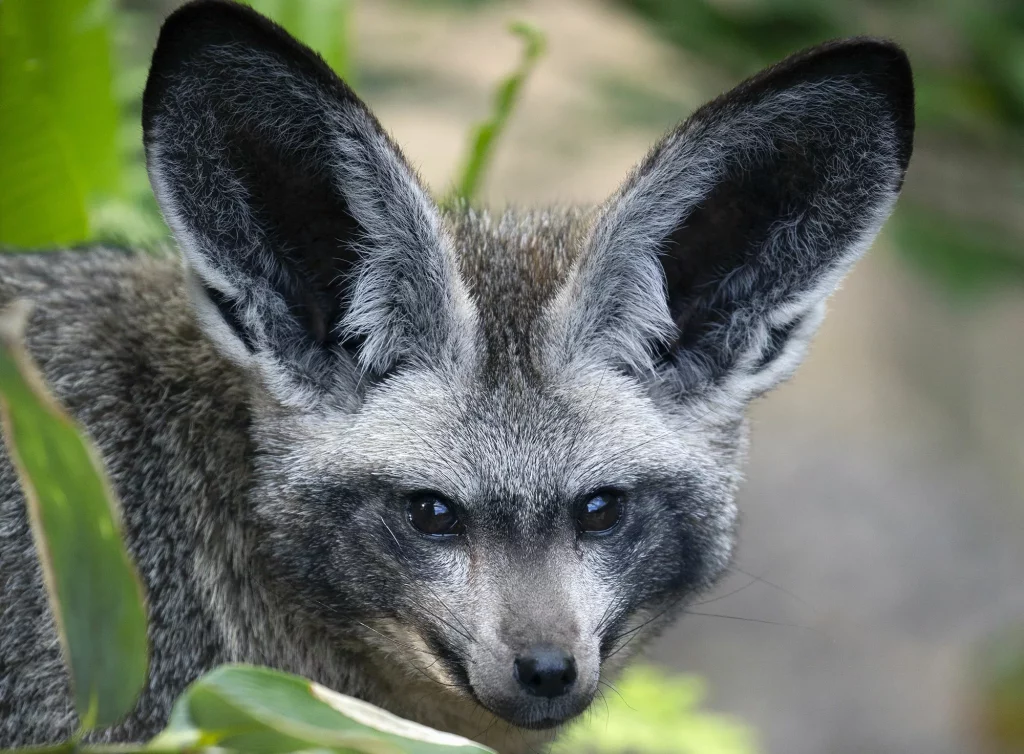Variety Overview
The bat-eared fox (scientific name: Otocyon megalotis) possesses ears similar to bat wings, which can grow up to 14 centimeters long. The species name “megalotis” comes from the Greek words “mega” and “otus,” meaning large ears. These oversized ears are crucial for communication, locating food, and other functions. Their fur color varies from pale yellow to deep honey, depending on age and habitat. The nose and mouth are larger compared to other foxes, with a gray-black hue and gray-white tips on the sides. They have sharp high teeth that allow them to quickly and efficiently chew insects for better digestion.
Features of the Appearance
The bat-eared fox gets its name from its notably large ears, which measure between 114 and 135 millimeters in length. Its fur is predominantly brownish-gray, with a grayish-white throat and abdomen. The outer edges of its ears appear to wear a “mask” similar to that of a brown bear. Its lower legs, paws, and tail tip are black. In addition to its large ears, the bat-eared fox’s unique dental structure sets it apart from other fox species. It possesses 46-50 teeth—more than any other placental mammal with heterodont dentition. Unlike other canids that typically have no more than two upper molars and three lower molars, the bat-eared fox has at least three upper molars and four lower molars. A prominent stepped digastric muscle in the mandible aids in the rapid chewing of insects.
The adult fox typically measures between 46-66 cm in body length and weighs around 3.0-5.3 kg. It has relatively short limbs.

Living Habits
Inhabiting arid grasslands and tropical savannas, these creatures prefer regions with short grass. They reside in burrows that they either dig themselves or take over from other animals. These burrows usually feature multiple entrances and chambers, along with tunnels that can stretch for several meters.
In the Serengeti Plains, bat-eared foxes are active 85% of the time at night. In South Africa, they come out during the day in winter and in the evening during summer. Studies in the Serengeti have shown that a bat-eared fox family’s territory ranges from about 0.25 to 1.5 square kilometers and is marked with urine to define boundaries. Each family comprises a pair of parents and their offspring who forage and rest together; they often lie close to each other, groom one another, play together, and offer mutual support. In South Africa, these families’ territories overlap significantly with little or no territorial marking; sometimes 2-3 burrows can be found within a few hundred meters apart with population densities reaching up to 10 individuals per square kilometer—possibly due to favorable local soil or vegetation conditions. Social living among bat-eared foxes helps them capture more termites and enhances hunting efficiency while providing opportunities for offspring to learn what is edible and how to hunt through imitation.
Play behavior among young foxes resembles escape behavior because adults often demonstrate avoidance rather than fighting.
Bat-eared foxes primarily feed on insects and other arthropods but occasionally consume small rodents, lizards, bird eggs, chicks, and plants; termites and dung beetles make up 80% of their diet. Ground-feeding termites are eaten as they pass by. These foxes obtain significant water from the body fluids of these insects. They are frequently seen around large herbivores like wildebeests, zebras, and buffaloes using their large ears to detect beetle larvae movements. While they generally forage alone, they may gather in large numbers where insects are plentiful; group foraging results in capturing more termites compared to solitary foraging at the same time and place.
